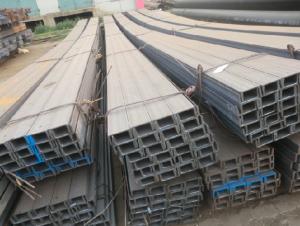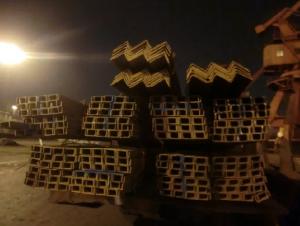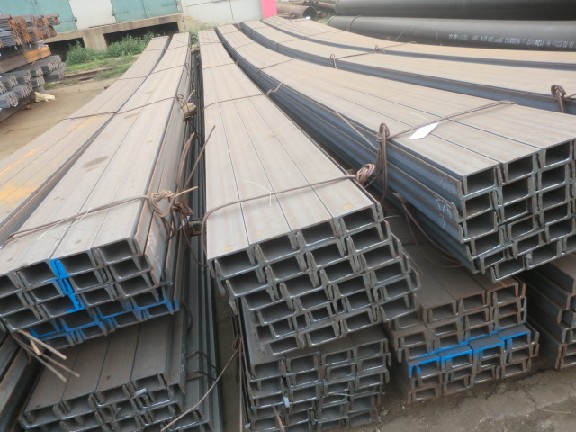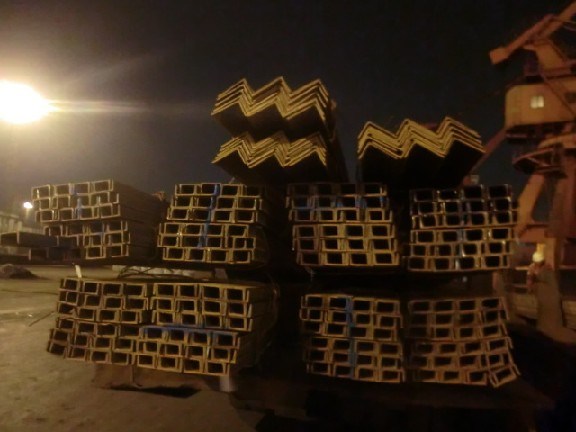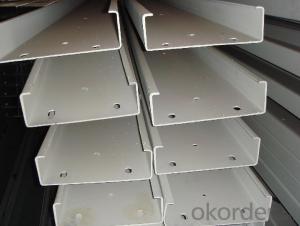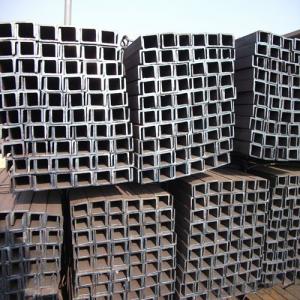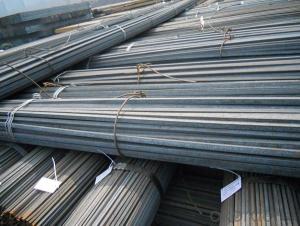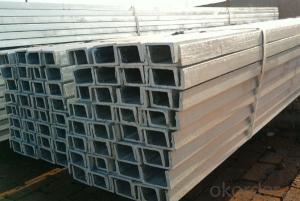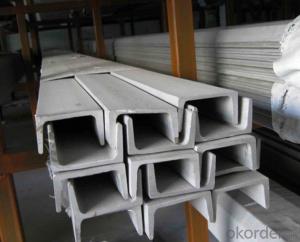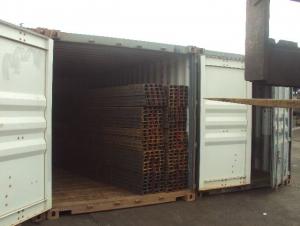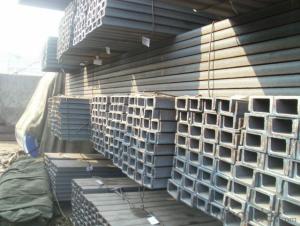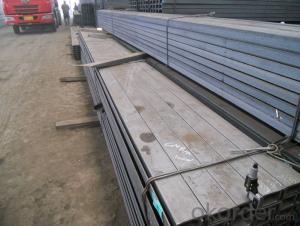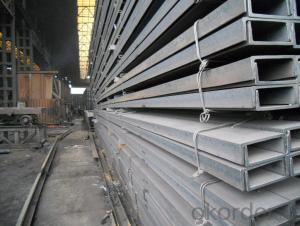JIS Standard U-channel Many Sizes
- Loading Port:
- China Main Port
- Payment Terms:
- TT or LC
- Min Order Qty:
- -
- Supply Capability:
- -
OKorder Service Pledge
OKorder Financial Service
You Might Also Like
Product Description:
OKorder is offering U-channel at great prices with worldwide shipping. Our supplier is a world-class manufacturer of steel, with our products utilized the world over. OKorder annually supplies products to European, North American and Asian markets. We provide quotations within 24 hours of receiving an inquiry and guarantee competitive prices.
Product Applications:
The UPN Channel Steel can be applied to construction of warehouses, workshops, sport stadiums and car parks etc.The hot rolled channel steel belongs to carbon structural steel which is applied to in the field of construction and machinery.In details, the hot rolled channel steel is usually used for arch-itechtural structure, and they could be welded in order to support or hang a vari-ety of facilities. They are also usually used in combination with I beam. Generally,the hot rolled channel steel we supply must possess perfect welding property, riveting property and mechanical property and so on.
Product Advantages:
OKorder's U-channel are durable, strong, and resist corrosion.
Main Product Features:
· Premium quality
· Prompt delivery & seaworthy packing (30 days after receiving deposit)
· Corrosion resistance
· Can be recycled and reused
· Mill test certification
· Professional Service
· Competitive pricing
Product Specifications:
1.Our UPN Channel Steel has lots of advantages, just as followings:
a) At reasonable price and good quality.
b) To be convenient in construction and to save much time and labor.
c) The length of UPN can be manufactured according to customer’s requirements.
d) The UPN Channel Steel has strong mechanical strength.
e). The UPN Channel Steel possesses various kind of fittings, through which it is suitbal for many combinations.
f) Our UPN Channel Steel is attractive in appearance as well as beautiful in design
g) Free from slotted punching
2. The detailed sections of our UPN Channel Steel can be found in table-1
UPN U CHANNEL | Standard h | Sectional b | Dimension s | t | Mass: Kg/m |
| (mm) | (mm) | (mm) | (mm) |
|
80x45 | 80 | 45 | 6.0 | 8.0 | 8.64 |
100X50 | 100 | 50 | 6.0 | 8.5 | 10.6 |
120x55 | 120 | 55 | 7.0 | 9.0 | 13.4 |
140x60 | 140 | 50 | 7.0 | 10.0 | 16.0 |
160x65 | 160 | 65 | 7.5 | 10.0 | 18.8 |
180x70 | 180 | 70 | 8.0 | 11.0 | 22.0 |
Note: we are definitely good at manufacturing and supplying UPN channel steel as per S235JR. Also, we are willing and able to provide our customers UPN channel steel in other sizes, which depends on customers’ concret requirements for the quantity.
FAQ:
Q1: Why buy Materials & Equipment from OKorder.com?
A1: All products offered byOKorder.com are carefully selected from China's most reliable manufacturing enterprises. Through its ISO certifications, OKorder.com adheres to the highest standards and a commitment to supply chain safety and customer satisfaction.
Q2: How do we guarantee the quality of our products?
A2: We have established an advanced quality management system which conducts strict quality tests at every step, from raw materials to the final product. At the same time, we provide extensive follow-up service assurances as required.
Q3: How soon can we receive the product after purchase?
A3: Within three days of placing an order, we will begin production. The specific shipping date is dependent upon international and government factors, but is typically 7 to 10 workdays.
Images:
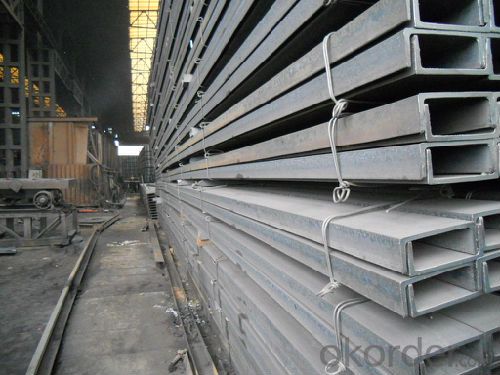
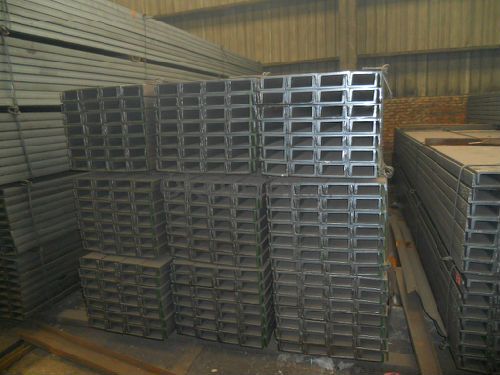
- Q: What is the purpose of a steel channel?
- A steel channel serves the function of providing structural support and reinforcement in different construction and engineering projects. It is typically crafted from steel and takes on the shape of a "C" with flanges on both sides. This design grants it greater strength and stability, leading to its popularity in applications requiring load-bearing capacity. In the realm of construction, bridges, buildings, and infrastructure often utilize steel channels due to their ability to withstand substantial weight and force. They commonly serve as beams or columns, supporting the weight of floors, walls, and roofs. Furthermore, in the installation of electrical systems, plumbing, and HVAC systems, steel channels frequently act as a conduit for wires, pipes, and ducts. Within the manufacturing sector, steel channels prove useful in fabricating frames, racks, and other structures demanding strength and durability. The automotive industry also frequently employs steel channels for creating vehicle frames, chassis, and body components. Their versatility and resistance to bending and deformation make them indispensable in many industrial and commercial applications. Overall, the primary purpose of a steel channel is to provide structural integrity, support heavy loads, and enhance the overall stability and durability of construction or engineering projects. With their versatility, strength, and ability to withstand various forces, they serve as a valuable component across multiple industries and a wide range of applications.
- Q: Steel arc bending machine can provide the best what? ` type details
- Is there a 3D molding requirement that will determine the number of NC shafts?.
- Q: What are the different applications of steel channels in the automotive industry?
- Steel channels are widely used in the automotive industry due to their various applications and benefits. Here are some of the different applications of steel channels in the automotive industry: 1. Structural Support: Steel channels are commonly used for structural support in automobile frames, chassis, and body panels. They provide strength and rigidity to support the weight of the vehicle and absorb impact forces during collisions. 2. Reinforcement: Steel channels are used to reinforce critical areas of the vehicle, such as door frames, pillars, and roof rails. They enhance the structural integrity and safety of the vehicle, especially in the event of a crash. 3. Suspension Components: Steel channels are utilized in the manufacturing of suspension components like control arms, sway bars, and trailing arms. These components provide stability, control, and smooth ride quality by connecting the wheels to the chassis. 4. Bumper Reinforcements: Steel channels are incorporated into the design of bumper reinforcements to enhance impact resistance and protect both the vehicle and occupants in case of a collision. They distribute and absorb energy during an impact, minimizing damage. 5. Exhaust Systems: Steel channels are utilized in exhaust systems to create the necessary channeling for the exhaust gases to exit the vehicle. These channels are designed to withstand heat, vibrations, and corrosion caused by the exhaust gases. 6. Seat Frames: Steel channels are commonly used in the construction of seat frames, providing strength and durability. They ensure the seats remain secure and stable, offering comfort and safety to the occupants. 7. Roll Cages: Steel channels are employed in the fabrication of roll cages, which are critical safety features in racing vehicles. Roll cages provide protection to the driver in the event of a rollover or crash, preventing the roof from collapsing. In summary, steel channels play a crucial role in the automotive industry, contributing to the strength, safety, and performance of vehicles. Their applications range from structural support and reinforcement to suspension components, bumper reinforcements, exhaust systems, seat frames, and roll cages.
- Q: What are the different surface treatments available for steel channels?
- There are several surface treatments available for steel channels, each designed to enhance the appearance and performance of the material. Some of the most common surface treatments for steel channels include: 1. Galvanization: This process involves coating the steel channel with a layer of zinc, which provides protection against corrosion. Galvanized steel channels are highly durable and can withstand exposure to harsh weather conditions, making them ideal for outdoor applications. 2. Powder coating: Powder coating involves applying a dry powder to the surface of the steel channel, which is then heated and cured to create a smooth, durable finish. This treatment provides excellent protection against corrosion, impact, and scratches, while also offering a wide range of color options. 3. Painting: Painting is a cost-effective surface treatment option that involves applying a layer of paint to the steel channel. This treatment not only enhances the appearance of the material but also provides protection against corrosion and environmental factors. 4. Anodizing: Anodizing is commonly used for aluminum channels, but it can also be applied to steel channels. This process creates a layer of oxide on the surface of the steel, which improves corrosion resistance and provides an aesthetically appealing finish. 5. Epoxy coating: Epoxy coating involves applying a layer of epoxy resin to the steel channel, which provides exceptional corrosion resistance and chemical resistance. This treatment is often used in industrial settings where the channels are exposed to harsh chemicals or extreme conditions. 6. Hot-dip coating: Hot-dip coating is similar to galvanization but involves immersing the steel channel in a molten zinc bath. This process creates a thick layer of zinc coating, offering enhanced corrosion protection and durability. It is important to consider the specific requirements and application of the steel channel when selecting a surface treatment. Each treatment has its own advantages and limitations, and choosing the right one will ensure the longevity and performance of the steel channel.
- Q: How do steel channels perform in terms of fire resistance?
- Steel channels perform well in terms of fire resistance due to their high melting point and structural integrity. They do not combust or release toxic fumes when exposed to fire, making them a reliable choice for construction in fire-prone areas. Additionally, steel channels can help maintain the integrity of a structure during a fire, providing support and preventing collapse.
- Q: How do steel channels perform in high-temperature applications?
- Steel channels perform well in high-temperature applications due to their excellent heat resistance and structural stability. The inherent strength and durability of steel allow channels to withstand extreme temperatures without significant deformations or weakening. Additionally, steel's thermal conductivity helps distribute heat evenly, preventing localized hotspots. Overall, steel channels are reliable and efficient in high-temperature environments, making them suitable for various industrial applications such as furnaces, heaters, and exhaust systems.
- Q: Can steel channels be used for utility supports?
- Yes, steel channels can be used for utility supports. Steel channels are strong and durable, making them suitable for supporting various utilities such as electrical cables, plumbing pipes, and HVAC systems. They provide stability and can withstand the weight and pressure of the utilities, ensuring a secure and reliable support system.
- Q: How do steel channels contribute to building stability?
- Steel channels contribute to building stability in several ways. Firstly, they provide structural support by distributing the weight and load of the building evenly, helping to prevent sagging or collapsing. Secondly, steel channels increase the overall strength of the structure, making it more resistant to external forces such as wind, earthquakes, and heavy loads. Additionally, steel channels can be used to create stiffening elements in walls, floors, and roofs, which enhance the building's rigidity and reduce any potential for excessive movement or deformation. Overall, steel channels play a vital role in ensuring the stability and safety of the building.
- Q: The base is a fixed support, and the load is evenly distributed at three points, respectively, at 50010001500 points and three points, the base is rigidly fixed, and the top is connected and fixed
- To know the situation of the beam support to determine the items to be checked, how about the channel support?
- Q: What are the design considerations for using steel channels in construction?
- When considering the use of steel channels in construction, there are several important design considerations that need to be taken into account. These considerations include structural integrity, load-bearing capacity, corrosion resistance, fire resistance, and overall cost-effectiveness. Firstly, steel channels are commonly used in construction due to their excellent structural integrity. They are known for their high strength-to-weight ratio, which allows for efficient use of materials in building structures. The design should take into account the specific load requirements and stresses that the steel channels will be subjected to, ensuring that they are appropriately sized and spaced to support the intended loads. Load-bearing capacity is another crucial consideration. The design of steel channels should be based on the expected loads that they will bear, whether it be from live loads such as people or equipment, or dead loads such as the weight of the building itself. Calculations and analysis should be performed to determine the required size and spacing of the channels to ensure they can safely support the intended loads without failure or deformation. Corrosion resistance is a vital consideration for steel channels, especially in construction projects where they may be exposed to moisture or harsh environmental conditions. Proper protective coatings or treatments should be applied to prevent rust and corrosion, ensuring the longevity and durability of the channels. Additionally, the design should consider drainage and ventilation to minimize the accumulation of moisture that could lead to corrosion. Fire resistance is also an important factor to consider. Steel channels can be vulnerable to high temperatures, which can weaken their structural integrity. Design considerations should include the use of fire-resistant materials, such as fire-rated coatings or intumescent paints, to enhance the fire resistance of the steel channels and prolong their load-bearing capacity under fire conditions. Lastly, cost-effectiveness plays a significant role in the design considerations for using steel channels in construction. The design should aim to optimize the use of steel channels, avoiding over-engineering while still meeting the required safety and performance standards. Additionally, the selection of steel grades and coatings should be balanced to provide the necessary level of performance at the most cost-effective price point. In conclusion, when using steel channels in construction, it is crucial to consider various design considerations such as structural integrity, load-bearing capacity, corrosion resistance, fire resistance, and cost-effectiveness. Taking these factors into account will ensure that the steel channels perform effectively and efficiently in the construction project, contributing to the overall success and longevity of the structure.
Send your message to us
JIS Standard U-channel Many Sizes
- Loading Port:
- China Main Port
- Payment Terms:
- TT or LC
- Min Order Qty:
- -
- Supply Capability:
- -
OKorder Service Pledge
OKorder Financial Service
Similar products
Hot products
Hot Searches
Related keywords
